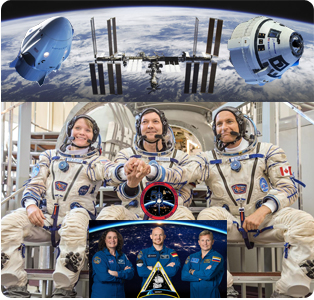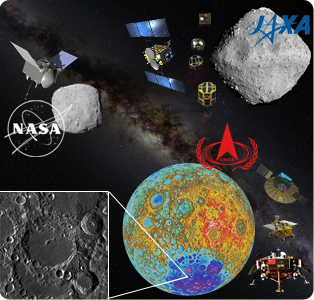International Space Station to Host New Crew and Spacecraft |
MONDAY Highlights…
|

![]() = All times
= All times
for terrestrial events in local time unless noted.
![]() = All times for international terrestrial events in local time unless noted.
= All times for international terrestrial events in local time unless noted.
![]() = All times for space events, and…
= All times for space events, and…
![]() = All times for international space / astro events in Hawaii Standard Time unless noted. Add 10 hours to obtain UT (‘Universal Time’).
= All times for international space / astro events in Hawaii Standard Time unless noted. Add 10 hours to obtain UT (‘Universal Time’).
Weekly Planet Watch – Evening Planets: Mars (S), Saturn (SW), Uranus (SE), Neptune (S); Morning Planets: Mercury (SE), Venus (ESE).
Asteroids Explored By Japan and USA,
|
Continued from…
TUESDAY
|
![]() Dec 4-6 — United Nations Office for Outer Space Affairs, China Manned Space Agency (CMSA), JAXA, Vienna, Austria: United Nations Expert Meeting on Human Space Technology: Providing Access to Space.
Dec 4-6 — United Nations Office for Outer Space Affairs, China Manned Space Agency (CMSA), JAXA, Vienna, Austria: United Nations Expert Meeting on Human Space Technology: Providing Access to Space.
![]() Dec 4-7 — ISAS /JAXA, University of Tokyo, Nagoya University, Sagamihara, Japan: Hayabusa 2018 Symposium.
Dec 4-7 — ISAS /JAXA, University of Tokyo, Nagoya University, Sagamihara, Japan: Hayabusa 2018 Symposium.
![]() Dec 4-7 — International Lunar Observatory Association, Chinese Society of Astronautics, NAOC, International Astronautical Federation, Canadian Space Agency, Wenchang, Hainan Island, China: Re-Set / Postponed to Late 2019 // ILOA Galaxy Forum Hainan: China.
Dec 4-7 — International Lunar Observatory Association, Chinese Society of Astronautics, NAOC, International Astronautical Federation, Canadian Space Agency, Wenchang, Hainan Island, China: Re-Set / Postponed to Late 2019 // ILOA Galaxy Forum Hainan: China.
![]() Dec 4 — Moon: 1.5° SSW of 1 Ceres, 03:13.
Dec 4 — Moon: 1.5° SSW of 1 Ceres, 03:13.
![]() Dec 4 — Amor Asteroid 2018 VZ3: Near-Earth Flyby (0.061 AU)
Dec 4 — Amor Asteroid 2018 VZ3: Near-Earth Flyby (0.061 AU)
WEDNESDAY
![]() Dec 5 — Goddard Space Flight Center, Greenbelt MD: Scientific Colloquium: Civilization and the Solar System: Cosmic Upheavals and Human History; Dagomar Degroot from Georgetown University.
Dec 5 — Goddard Space Flight Center, Greenbelt MD: Scientific Colloquium: Civilization and the Solar System: Cosmic Upheavals and Human History; Dagomar Degroot from Georgetown University.
![]() Dec 5 — Moon: 1.8° NNE of Mercury, 12:00.
Dec 5 — Moon: 1.8° NNE of Mercury, 12:00.
![]() Dec 5 — Apollo Asteroid 2018 VK5: Near-Earth Flyby (0.067 AU)
Dec 5 — Apollo Asteroid 2018 VK5: Near-Earth Flyby (0.067 AU)
![]() Dec 5 — Aten Asteroid 2017 RH16: Near-Earth Flyby (0.081 AU)
Dec 5 — Aten Asteroid 2017 RH16: Near-Earth Flyby (0.081 AU)
THURSDAY
![]() Dec 6 — Lunar and Planetary Institute, Houston TX: Ocean World and Martian Sub-ice Access and Exploration Technology: How close are we to viable flight vehicles? by Bill Stone of Stone Aerospace.
Dec 6 — Lunar and Planetary Institute, Houston TX: Ocean World and Martian Sub-ice Access and Exploration Technology: How close are we to viable flight vehicles? by Bill Stone of Stone Aerospace.
![]() Dec 6 — Cornell University, Ithaca NY: Exoplanet Frontiers: Kepler and the Next Decade of Exoplanet Exploration; by Natalie Batalha of UC Santa Cruz.
Dec 6 — Cornell University, Ithaca NY: Exoplanet Frontiers: Kepler and the Next Decade of Exoplanet Exploration; by Natalie Batalha of UC Santa Cruz.
![]() Dec 6 — Library of Congress – Science, Technology and Business Division, Washington DC: The Science of Space: Heliophysics and the Parker Solar Probe; by C. Alex Young from NASA.
Dec 6 — Library of Congress – Science, Technology and Business Division, Washington DC: The Science of Space: Heliophysics and the Parker Solar Probe; by C. Alex Young from NASA.
![]() Dec 6-8 — National Solar Observatory, AURA, Northumbria University, Science & Technology Facilities Council, et al, Las Cruces NM: Critical Science Plan Workshop 5: Wave Generation and Propagation.
Dec 6-8 — National Solar Observatory, AURA, Northumbria University, Science & Technology Facilities Council, et al, Las Cruces NM: Critical Science Plan Workshop 5: Wave Generation and Propagation.
![]() Dec 6 — Moon: 3.4° NNE of Jupiter. 05:00; 8.4° NNE of Antares, 13:00; New Moon, 21:21.
Dec 6 — Moon: 3.4° NNE of Jupiter. 05:00; 8.4° NNE of Antares, 13:00; New Moon, 21:21.
FRIDAY
![]() Dec 7 — Akatsuki, Venus Orbit: JAXA first successful planetary orbiter imaging Venus atmosphere, monitoring weather changes reaches 3 full years / enters 4th year at Venus today, reached Venus 2015.
Dec 7 — Akatsuki, Venus Orbit: JAXA first successful planetary orbiter imaging Venus atmosphere, monitoring weather changes reaches 3 full years / enters 4th year at Venus today, reached Venus 2015.
![]() Dec 7 — ULA, Launch Delta 4-Heavy / NROL-71, Vandenberg AFB CA: ULA Delta 4-Heavy rocket to launch classified U.S. NRO payload.
Dec 7 — ULA, Launch Delta 4-Heavy / NROL-71, Vandenberg AFB CA: ULA Delta 4-Heavy rocket to launch classified U.S. NRO payload.
![]() Dec 7 — International Lunar Observatory Association, Chinese Society of Astronautics, NAOC, International Astronautical Federation, Beijing, China: Galaxy Forum China 2018: Beijing; themed Astronomy from the Moon, and International Human Moon Missions.
Dec 7 — International Lunar Observatory Association, Chinese Society of Astronautics, NAOC, International Astronautical Federation, Beijing, China: Galaxy Forum China 2018: Beijing; themed Astronomy from the Moon, and International Human Moon Missions.
![]() Dec 7 — Puppid Meteor Shower Peak: Appearing to radiate from constellations Puppis, Vela and Carina, up to 10 meteors per hour expected (some very bright) seen from southern hemisphere.
Dec 7 — Puppid Meteor Shower Peak: Appearing to radiate from constellations Puppis, Vela and Carina, up to 10 meteors per hour expected (some very bright) seen from southern hemisphere.
![]() Dec 7 — Mars: 0.04° NNW of Neptune, 04:00.
Dec 7 — Mars: 0.04° NNW of Neptune, 04:00.
SATURDAY
![]() NET Dec 8 — CNSA, Launch Long March 3B / Chang’e-4 Lander & Rover, Xichang Satellite Launch Centre, China: Attempting first-ever landing on Moon far side at northwestern South Pole – Aitken basin 180-km diameter Von Kármán crater (45-46° S, 176.4-178.8° E); launching 1,200-kg lander / 140-kg rover at ~02:30 local time with low-frequency spectrometer, landing and ground cameras, Lunar Lander Neutrons and Dosimetry Experiment, and potato & Arabidopsis thaliana seeds, silkworm eggs, international payloads from Sweden, Germany, Netherlands and Saudi Arabia; may land Dec 30 or 31.
NET Dec 8 — CNSA, Launch Long March 3B / Chang’e-4 Lander & Rover, Xichang Satellite Launch Centre, China: Attempting first-ever landing on Moon far side at northwestern South Pole – Aitken basin 180-km diameter Von Kármán crater (45-46° S, 176.4-178.8° E); launching 1,200-kg lander / 140-kg rover at ~02:30 local time with low-frequency spectrometer, landing and ground cameras, Lunar Lander Neutrons and Dosimetry Experiment, and potato & Arabidopsis thaliana seeds, silkworm eggs, international payloads from Sweden, Germany, Netherlands and Saudi Arabia; may land Dec 30 or 31.
![]() Dec 8 — Fort Macon State Park, Atlantic Beach NC: Exploring the Heavens – From Hubble to the Webb – Discovering Space through the eyes of a Telescope; featuring Lisa Pelletier-Harman of NASA Solar System Ambassadors Program.
Dec 8 — Fort Macon State Park, Atlantic Beach NC: Exploring the Heavens – From Hubble to the Webb – Discovering Space through the eyes of a Telescope; featuring Lisa Pelletier-Harman of NASA Solar System Ambassadors Program.
![]() Dec 8 — Moon: 1.1° N of Saturn, 19:00.
Dec 8 — Moon: 1.1° N of Saturn, 19:00.
SUNDAY
![]() Dec 9-14 — European Southern Observatory, Pucon, Chile: Conference: The Galactic Bulge at the Crossroads (GBX2018).
Dec 9-14 — European Southern Observatory, Pucon, Chile: Conference: The Galactic Bulge at the Crossroads (GBX2018).
![]() Dec 9 — Moon: 0.73° N of Pluto, 17:00.
Dec 9 — Moon: 0.73° N of Pluto, 17:00.
![]() Dec 9 — Apollo Asteroid 2013 VX4: Near-Earth Flyby (0.011 AU)
Dec 9 — Apollo Asteroid 2013 VX4: Near-Earth Flyby (0.011 AU)

